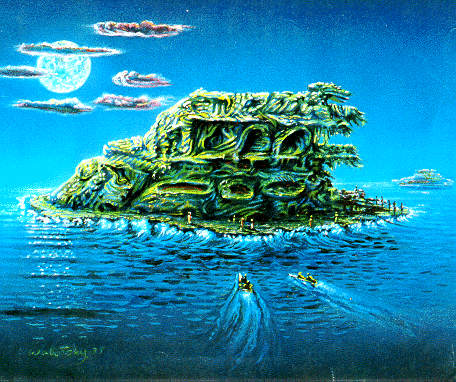

The telltale indicator of a seaswallower is the massive whirlpool that it creates, thus generating the "swallowing" effect that gives it its' name. In fact, this is all that is ever seen of the giant cephaglobinid, because the only people to get close enough to the source of the whirlpool never again see the light of day. Therefore, the actual structure and anatomy of a seaswallower has been a mystery of mythological proportions to the Sharers, and to anyone else for that matter. Until now. Employing a technique whose details must be kept secret for the sake of interstellar security (as well as my own financial security: patent #129984737493929485858), I managed to capture one of these remarkable beasts. Eat your heart out, Jacques Cousteau. The technique is highly sophisticated, but I'll give you a hint: A similar (but not identical) method was used during a certain Star Trek motion picutre.

The seaswallower is somewhat wormlike in the sense that it has a vast, hollow body cavity with which to intake food. Couple that with the mystery and majestic power of the seaswallower and we are reminded of the sandworms in the fictional story Dune, by Frank Herbert. Much like the sandworm, the seaswallower plays a unique and crucial role in the balance of the ecosystem in which it lives. Every year, these enormous beast migrate to and from each pole of the planet, swallowing virtually anything that is floating on the surface of the ocean and is small enought to be sucked in. This essentially "cleans" the planet, and without the seaswallower, Shora becomes littered with debris, and the delicate ecosystem is thrown off balance. Because of it's important role in the life cylce of Shora, and because of its' great size, the seaswallower has been elevated to almost divine levels, much like the Hai-Shalud (Sandworm) on Arrakis. However, a sandworm was never dissected in quite the manner that I examined the seaswallower.

Just as photographs are not allowed to be taken in courtrooms, neither are they allowed to be taken at my lab. Therefore, only a drawing of the seaswallower and schematics of its' complex anatomy will be provided.
Sources:
-Slonczewski, Joan. A Door Into
Ocean, Arbor House, New York, 1986
-Turner, Paula. Assistant professor
of physics, Kenyon College. Verbal conversation on 12/1/97.